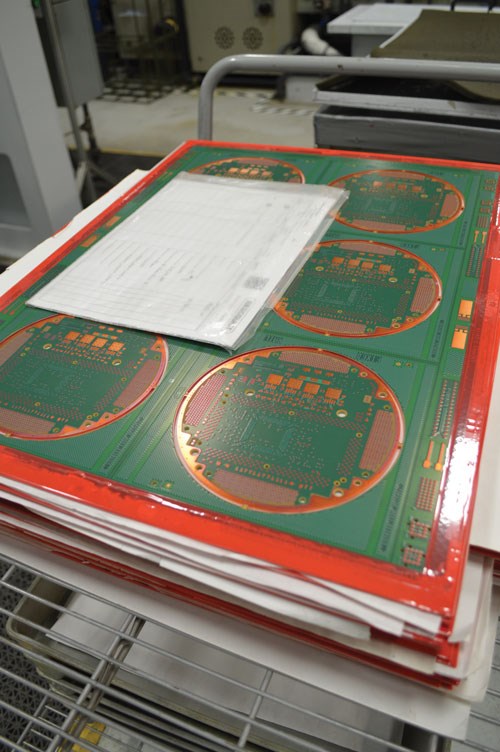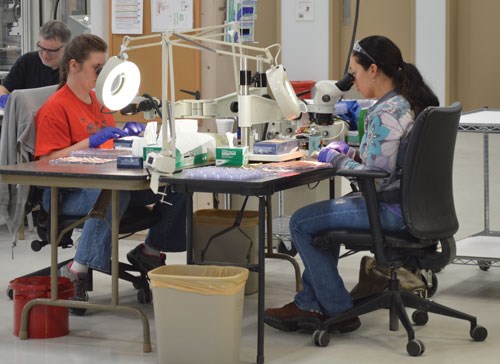Bright Lights, Big Finish for Electronics Plater
Wisconsin manufacturer of printed circuit boards for the LED lighting industry and others in the electronics sector has seen business boom in the past few years.
#pollutioncontrol #electronics #masking

Featured Content
Business of late for Berquist Co. has been lights out.
Rather, we should say lights on … lots and lots of lights.
The Prescott, Wisconsin, manufacturer of printed circuit boards for the LED lighting industry and others in the electronics sector has seen business boom in the past few years thanks to a move to the longer-lasting and more environmentally friendly lighting system.
“The last several years have been very good for us,” says Dave Sommervold, Bergquists’ engineering manager of its thermal substrates division. “And it seems like it will be getting even better.”
The increase in demand spurred Berquist to build its own automated plating line in 2011, bringing the work inside after outsourcing it for many years to a Minneapolis plating shop.
It was a need to have better control over production and operations as the company’s sales grew in a highly competitive industry.
“There’s always a need to improve your turnaround time as much as you can, as well as get control over quality and operations,” Sommervold says. “More than anything, we just wanted to make sure as we were bringing in a lot of new customers that we were not having any quality issues.”
New Automated Plating Line
The automated line allows for Bergquist to plate about 1,500 PCB panels each week running three shifts a day for five days. The equipment also gives them the ability to plate for several other companies in the nearby Minneapolis and St. Paul areas of Minnesota.
“It’s really been a huge benefit to our entire operation to have our own line,” Sommervold says. “It’s better than we could have imagined.”
Headquartered in nearby Chanhassen, Minnesota, the Bergquist Co. is a privately held, family owned business started by Carl Bergquist in the 1960s. He began by distributing electronic components in the Midwest, and the company had grown to three main divisions: thermal products, membrane switches and touch screens.
Bergquist has three manufacturing plants in the U.S., as well as manufacturing, sales and marketing support throughout the world.
In the mid-1970s, a telecom company asked Carl to develop a material to replace mica and grease behind power transistors. His engineering team spent countless hours in his research lab, but eventually developed what is now known as Sil-Pad thermal interface material, a product that quickly became successful and spurred many related products for the company.
100,000-sq-ft Space
The Prescott facility where Sommervold works manufactures the company’s Thermal Clad printed circuit board in a 100,000 square foot facility, which Bergquist officials say is the only facility in the world completely dedicated to the production of insulated metal substrates (IMS).
The Thermal Clad IMS was developed by Bergquist as a thermal management solution for today’s higher watt-density surface mount applications where Sommervold says die size is reduced and heat issues are a major concern.
“Thermal Clad substrates minimize thermal impedance and conduct heat more effectively and efficiently than standard PWBs,” he says. “These substrates are more mechanically robust than thick-film ceramics and direct bond copper constructions that are often used in these applications.”
Most of the circuit boards manufactured and plated at Bergquist’s Prescott facility are for light emitting diodes—or LEDs—which have been around for several years, but have grown in concentration in markets such as mobile phones and other consumer electronics.
Sommervold says that historically, protecting low power LEDs wasn’t a big concern amongst manufacturers because the commercial product would fail or become obsolete long before the LED failed. But as technological advancements in LED design and processes are improving, the need to better protect the LEDs against heat build-up is more important.
Chip-on-board (COB), ceramic submounts and other thermally efficient packages are emerging as the standard thermal management packaging solution for power LEDs.
Unique Services
Plating these unique surfaces and substrates were a concern when Bergquist first decided to bring their plating line in-house. Sommervold was familiar with the plating process, having worked in a Twin Cities shop for several years before joining Bergquist in 1996.
“But there still remains a lot of unique challenges when you work with printed circuit boards,” he says. “These are some highly-sophisticated pieces of technology that needed to be built right, and so everything that went into them—even the plating—needed to be top notch.”
For that, Berquist contacted Uyemura International in Ontario, California, one of the foremost experts in PCB plating finishes.
Sommervold knew of Uyemura from his dealings with IPC, the global trade association serving the printed board and electronics assembly industries. The Bergquist team quickly connected with Uyemura’s Technical Center in Southington, Connecticut, where they worked with Don Walsh, the Director of Operations for the center.
The line that Uyemura designed for Bergquist is used for electroless nickel/immersion gold (ENIG), electroless nickel/electroless palladium/immersion gold (ENEPIG), and for immersion silver.
ENIG Plating
George Milad, national accounts manager for Uyemura, says that ENIG is formed by the deposition of electroless nickel-phosphorous on a catalyzed copper surface, followed by a thin layer of immersion Gold. The IPC ENIG specification, IPC-4552, specifies 120-240 micro-inches (µins) of Ni with 2-4 micro-inches (µins) of immersion gold.
“ENIG is a very versatile surface finish,” Milad says. “It is a solderable surface, aluminum wire bondable, and an excellent electrical contacting surface. It has excellent shelf life, in excess of 12 months, is easy to inspect and the thickness is easily verified by non-destructive XRF measurement.”
He says that ENIG continues to gain market share, especially following the elimination of the “Black Pad” issue, where a compromised nickel surface is corroded by prolonged exposure to the immersion gold deposition step.
ENEPIG is formed by the deposition of electroless Ni (120-240 micro inches) followed by 4-8 micro inches of electroless Pd with an immersion gold flash (1-2 micro inches).
“ENEPIG is the finish with the widest latitude for a variety of applications,” Milad says. “It is sometimes referred to as the ‘universal’ finish, because of its usage versatility, and it also is suitable for soldering, gold wire bonding, aluminum wire bonding, and contact resistance.”
Sommervold says Berquist was extremely pleased with the service and expertise he received from Uyemura’s staff in getting the plating line built and running efficiently.
High Accolades
“Being so involved in the PCB industry, I knew of Uyemura and everyone I spoke with had such high regards and accolades for them,” he says. “And when we started working together, I was really impressed how much they bent over backwards for us at every turn. Their technical support was fantastic.”
Bergquist relied on Uyemura’s experts for advice on how to plate certain substrates, and for minute details on different aspects of the plating process.
“To tell you the truth, there were times when they offered extremely helpful advice on things that didn’t directly involve the plating line they installed for us,” Sommervold says. “You couldn’t ask for anything more from them.”
Uyemura has brought a variety of plating products to the PCB industry, including:
ACL-634: a through-hole cleaner for ENIG, this acid-type soaking cleaner is well suited for the pretreatment in electroless Ni/Au processes with non-plating through hole.
MNK-4 Palladium Catalyst: an EN plating activator for fine pattern PCBs that eliminates the potential for bridging between pads.
Nimuden NPR-4: an acid EN plating bath specially formulated for electronic and PCB with fine line circuitry, it allows the deposition of electroless nickel without bridging.
Nimuden NPR-8: a mildly acidic EN-phosphorus process for EN/gold plating to selective PWBs with dry film masking.
TAM-55 Immersion Gold: minimizes nickel corrosion and optimizes gold distribution; protects and maintains the solderability of the electroless nickel in an ENIG deposit.
Talon: the most popular of Uyemura’s market-leading electroless palladiums for ENEPIG production
Municipal Lighting Push
The new line has helped Bergquist fulfill even more orders as the LED market has boomed over the past few years. A case in point is the push to get municipal lighting on streets converted to the new LED format.
In 2012, Los Angeles completed the largest LED street light replacement program in the world, retrofitting more than 141,000 street lights with LED bulbs, with the PCBs manufactured and plated by Bergquist.
Before the switch, Los Angeles’ street lights consumed 168 gigawatt hours of electricity each year at a cost of $15 million, while also emitting 110,000 metric tons of carbon dioxide. The new lights now cost $7 million less to run, reduce energy use by 63 percent and reduce carbon emissions by 47,583 metric tons a year, according to city officials.
But one of the biggest examples of Bergquist’s circuit board handiwork is the lighted ball that falls in New York’s Times Square every Dec. 31. The new 12-foot-wide ball was made in 2008 and weighs almost 12,000 pounds, and features 32,256 LEDs encased in 2,688 sculpted Waterford crystals.
The circuitry build by Bergquist allows for more than 16 million colors to be generated by the LEDs.
But besides LED lighting, Bergquist has also done plenty of PCBs for the automotive and military industry. About 50 percent of the boards are shipped overseas to Asia and Europe, and the work appears to be picking up even more steam as most all technology today is driven by circuitry.
“We expect to continue growing, and we’ll probably be expanding even more,” Sommervold says.
To learn more about Berquist Co., please visit Bergquistcompany.com. For information on Uyemura International Corp., please visit Uyemura.com
RELATED CONTENT
-
Treating Plating Wastewater
Wastewater from plating facilities contains contaminants such as heavy metals, oil and grease and suspended solids at levels that might be considered environmentally hazardous . . .
-
NOx Scrubbing Technology Breakthrough
This paper presents research findings and practical results that address the treatment of the problematic greenhouse gases nitrogen oxides (NOx) and sulfur dioxide (SO2).
-
Zinc Phosphate: Questions and Answers
Our experts share specific questions about zinc phosphate and pretreatment





















